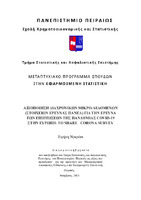| dc.contributor.advisor | Τήνιος, Πλάτων | |
| dc.contributor.author | Νγκρέσι, Ειρήνη | |
| dc.date.accessioned | 2023-12-07T11:57:33Z | |
| dc.date.available | 2023-12-07T11:57:33Z | |
| dc.date.issued | 2023-11 | |
| dc.identifier.uri | https://dione.lib.unipi.gr/xmlui/handle/unipi/16084 | |
| dc.identifier.uri | http://dx.doi.org/10.26267/unipi_dione/3506 | |
| dc.description.abstract | Η παρούσα διπλωματική εργασία έχει ως στόχο την διερεύνηση ύπαρξης συσχέτισης
μεταξύ ευαλωτότητας (υγείας και οικονομική) και μέτρων προστασίας σε άτομα άνω
των 50 ετών κατά την διάρκεια της πανδημίας. Για τον σκοπό αυτό αξιοποιούνται
πληροφορίες από το όγδοο κύμα της πανευρωπαϊκής έρευνας SHARE που αφορά τον
Covid-19 (Survey of Health, Ageing and Retirement in Europe). Τα χαρακτηριστικά
που εξετάζονται είναι δημογραφικά, οικονομικά(οικονομική ευαλωτοτητα) και υγείας
(ευαλωτοτητα υγείας). Στο πρώτο κεφάλαιο παρουσιάζονται ορισμοί που αφορούν την
έννοια της ευαλωτότητας και γενικές πληροφορίες για την πανδημία Covid-19 και η
σύνδεση αυτής με προ υπάρχουσες ασθένειες. Στο δεύτερο κεφάλαιο θα δώσουμε
έμφαση στο πως κάθε χώρα αντιμετώπισε τον Covid-19. Βλέπουμε τα μέτρα που πήραν
οι χώρες της Ευρώπης αλλά και το Ισραήλ. Καθώς τα δεδομένα μας πάρθηκαν από το
SHARE το επόμενο κεφάλαιο αναφέρεται σε αυτό. Ξεκινώντας με το τι είναι το
SHARE και αναφερθήκαμε και στα πλεονεκτήματα του. Για την ανάλυση των
δεδομένων της έρευνάς SHARE γίνεται χρήση του στατιστικού πακέτου SPSS.
Ειδικότερα, στο τέταρτο κεφάλαιο εξετάζεται μέσω της διδιάστατης ανάλυσης αν και
σε τι βαθμό σχετίζεται η ευαλωτότητα με την λήψη μέτρων προστασίας. Το πέμπτο
κεφάλαιο αποτελεί την κατακλείδα της παρούσας εργασίας, στο οποίο καταγράφονται
τα κυριότερα συμπεράσματα της έρευνα. Πιο συγκεκριμένα οι γυναίκες έχουν
χαμηλότερη πιθανότητα να λάβουν μέτρα προστασίας συγκριτικά με τους άνδρες και
άτομα τα οποία χαρακτηρίσαμε οικονομικά ευάλωτα στον κόβιντ του 2020 και 2021
έχουν χαμηλότερη σχετική πιθανότητα να λάβουν μέτρα προστασίας συγκριτικά με
τα άτομα που δεν ήταν οικονομικά ευάλωτοι, ενώ όσοι ήταν ευάλωτοι (ως προς την
υγεία) είχαν και υψηλότερη σχετική πιθανότητα να λάβουν μέτρα προστασίας | el |
| dc.format.extent | 60 | el |
| dc.language.iso | el | el |
| dc.publisher | Πανεπιστήμιο Πειραιώς | el |
| dc.rights | Αναφορά Δημιουργού-Μη Εμπορική Χρήση-Όχι Παράγωγα Έργα 3.0 Ελλάδα | * |
| dc.rights.uri | http://creativecommons.org/licenses/by-nc-nd/3.0/gr/ | * |
| dc.title | Αξιοποίηση διαχρονικών μικρο-δεδομένων (στοιχείων έρευνας πάνελ) για την έρευνα των επιπτώσεων της πανδημίας Covid-19 στην Ευρώπη : το SHARE Corona Survey | el |
| dc.title.alternative | Utilisation of panel micro data to study the impact of Covid-19 in Europe : the SHARE data | el |
| dc.type | Master Thesis | el |
| dc.contributor.department | Σχολή Χρηματοοικονομικής και Στατιστικής. Τμήμα Στατιστικής και Ασφαλιστικής Επιστήμης | el |
| dc.description.abstractEN | This thesis aims to investigate the existence of a correlation between vulnerability
(health and economic) and protection measures in people over 50 years old during the
pandemic. For this purpose, information from the eighth wave of the pan-European
SHARE survey concerning Covid-19 (Survey of Health, Aging and Retirement in
Europe) is used. The characteristics examined are demographic, economic (economic
vulnerability) and health (health vulnerability). The first chapter presents definitions
regarding the concept of vulnerability and general information about the Covid-19
pandemic and its connection to pre-existing diseases. In the second chapter we will
emphasize how each country dealt with Covid-19. We see the measures taken by the
European countries and Israel as well. As our data was taken from SHARE the next
chapter refers to it. Starting with what SHARE is and we also talked about its
advantages. The SPSS statistical package is used to analyze the data of the SHARE
survey. In particular, the fourth chapter examines through the two-dimensional analysis
whether and to what extent vulnerability is related to the adoption of protection
measures. The fifth chapter is the conclusion of this work, in which the main
conclusions of the research are recorded. More specifically, women have a lower
probability of taking protective measures compared to men, and people whom we
characterized as economically vulnerable to covid 2020 and 2021 have a lower relative
probability of taking protective measures compared to people who were not
economically vulnerable, while those who were vulnerable (in terms of health) also had
a higher relative probability of taking protective measures. | el |
| dc.contributor.master | Εφαρμοσμένη Στατιστική | el |
| dc.subject.keyword | Επιπτώσεις | el |
| dc.subject.keyword | Πανδημία | el |
| dc.date.defense | 2023-11-28 | |



